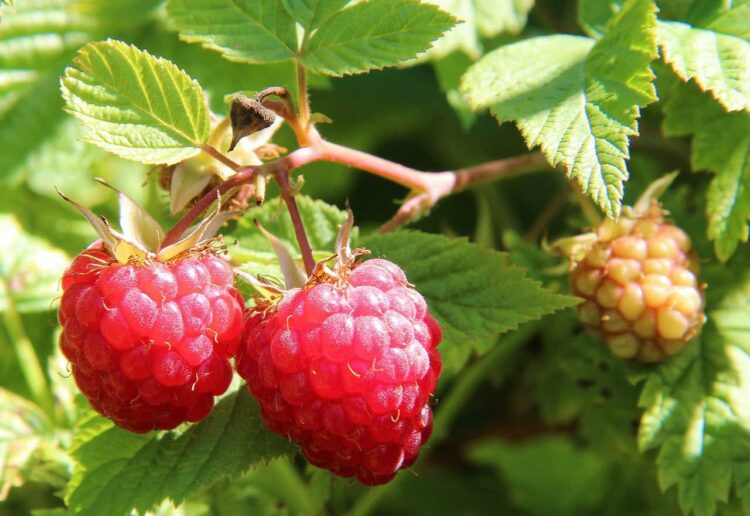Table of Contents
Can stick insects eat raspberry leaves? That’s a question that might be on your mind if you have an abundance of these leaves near to where you live and you want to try them.
Raspberry plants are considered brambles, and many stick insect species eat bramble leaves. To see if your species eats raspberry leaves, just place some in their enclosure and wait to see. Don’t worry as stick insects will not eat anything they don’t like or is otherwise harmful to them.
Take comfort in this fact that stick insects are particularly good about not eating leaves that are toxic to them. So if you are forced to turn to raspberry leaves because you do not have access to other leaf types, you could always try it and see what happens. If you put a few raspberry branches in your enclosure and notice the insects will not go near them, it’s a good bet they never will.
On the other hand, discovering your stick insect will eat raspberry makes feeding a lot easier. Raspberry is quite plentiful in the wild. You can also get it from local arborists, nurseries, and flower shops.
For more advice and information on keeping and looking after stick insects, check out my ebook on Amazon click here
(opens in a new tab).

More About Raspberry
You may find this ironic, but raspberry is not the name of the plant that bears the fruit of the same name. Raspberry is actually the name of the fruit produced by the rubus plant. Don’t worry though, if you go into your garden centre looking for raspberry leaves, they will know what you’re talking about.
As for the rubus, it is a member of the rose family. This is important in that stick insects with a fondness for rose leaves will probably also eat raspberry as well. That is not always guaranteed, but the chances are pretty high.
will probably also eat raspberry as well. That is not always guaranteed, but the chances are pretty high.
The good thing about rubus is that it offers a nice, woody stem that stick insects are rather fond of. It is a perennial though, so you’re not going to find leaves in the wild year-round. Come early autumn, raspberry in the wild will kind of fade away, not to be seen again until spring.
Raspberry is grown around the world as a main crop for human consumption. As such, you should not have any trouble finding it somewhere in your local area. As always, remember that rubus found along a roadside could be contaminated with exhaust from passing cars. Any plants bought from a shop or found by the roadside will have to be washed thoroughly to address pesticides and particulates.
Feeding Your Insect Raspberry
Assuming you are not sure that your stick insect will eat raspberry, you can introduce it slowly along with another food you’ve been using all along. So perhaps instead of putting down two bramble branches, you can put down one bramble and one raspberry. Then just see what happens.
Note that the look of the rubus stem is such that it can be difficult to find certain species of stick insects sitting on it. This can make changing out rubus branches a little challenging. One way around this is to place new branches within the same general vicinity as the old branches and just wait a couple of days. The stick insects will naturally gravitate to the new branches, given that they are fresher. You can then remove the old branches a couple of days later and be fairly confident that you will not take any insects with them.
Combining Raspberry with Other Foods
Can stick insects eat raspberry leaves and other foods simultaneously? Technically, yes. If your stick insects are fond of raspberry, bramble, privet , and rose, it is technically possible to put all four kinds of leaves in your enclosure. The real question is whether or not doing so is smart.
, and rose, it is technically possible to put all four kinds of leaves in your enclosure. The real question is whether or not doing so is smart.
While stick insects can adapt to a wide variety of food sources, they do tend to be choosy once they find something they like. Give them too many choices and you can, believe it or not, create finicky eaters. It is better to find one particular food that you know they will eat and then stick with it for as long as possible.
Yes, stick insects can eat raspberry leaves. The Indian stick insect, which is the species most commonly kept as pets, will eat quite a variety of leaves . There should be no problem with raspberry leaves. As for some of the other species, those commonly found in schools and laboratories (apart from the Indian stick insect) also tend to be very open to new food sources. They shouldn’t have a problem with raspberry either.
. There should be no problem with raspberry leaves. As for some of the other species, those commonly found in schools and laboratories (apart from the Indian stick insect) also tend to be very open to new food sources. They shouldn’t have a problem with raspberry either.
You will not get into trouble with raspberry unless you own some of the more exotic species that are harder to come by. If you’re not sure, you can always search the internet for the answers you are looking for.


